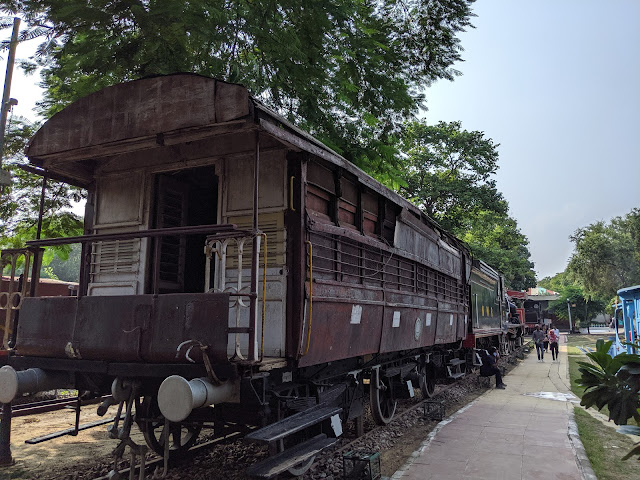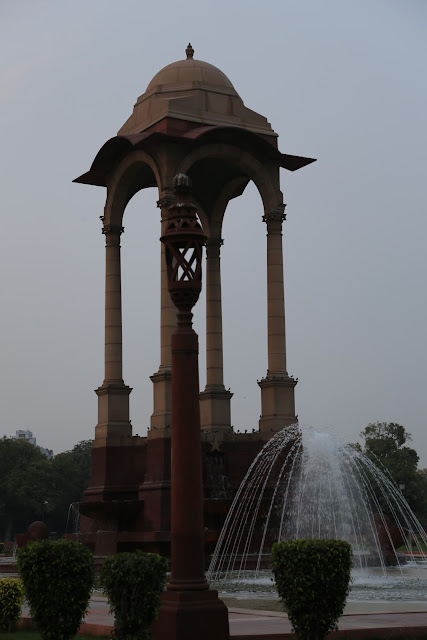03-October-2019
I had been thinking about visiting Humayun's Tomb for quite some time. So decided to visit that place.
As you reach Humayun's Tomb complex, the first tomb is the Isa Khan's Tomb.
Isa Khan's Tomb
Isa Khan Niyazi was a noble in the court of Sher Shah Suri. The enclosure for his tomb was built during his own lifetime. The tomb is octagonal and predates Humayun's tomb by 20 years. It has striking ornamentation in the form of canopies, glazed tiles, and lattice screens.
Isa Khan's tomb pre-dates Humayun's Tomb by two decades and is the culmination of an architectural style used for royal tombs in Delhi during the Sayyid and Lodi dynasties from the early 15th to the early 16th centuries. It is the only surviving octagonal enclosed tomb complex with walls, mosque, and gateway intact.
 |
| Isa Khan's Tomb |
Conservation works at the site commenced in January 2011 following extensive documentation, including 3D high-definition surveying, condition assessment, archival research and a peer review of the conservation plan.
An enormous amount of work was required to remove some 325,000 cubic feet of earth from the site in order to restore the landscape to its original level while being careful not to destroy any archaeology. Conservation and Landscape works are carried out with due care of the authenticity of material and building tradition and have restored the integrity of the Humayun's tomb World
Heritage Site.
The Aga Khan Trust for Culture with co-funding of World Monuments Fund and in partnership with
the Archaeological Survey of India undertook the conservation of Isa Khan's Garden - Tomb, Mosque and Gateway during 2011-13. Tilework on the canopies and facade was restored in 2014.
Bu-halima Gateway
Aligned in axis with the western gate of Humayun's Tomb enclosure and Subz burj, the 16th Century gateway to Bu Halima Garden Tomb stands on the eastern side of the enclosure. The upper arched opening has sandstone jarokha with beautiful lattice parapet which is supported on decorative sandstone brackets. Remains of the original tilework decoration are still existing on the parapet.
On the lower level, alterations to the plinth had been carried out in the past to enable the use of the space as a ticket counter. On the basis of a careful study, the additional concrete layers will be removed.
Conservation works are now been undertaken and addressing the serious issues of deteriorations by carefully removing all the cement and other modern plastered portions, on the facade and the interior
spaces. All the cement lattice screens that are presently fixed to the arched openings will be replaced with handmade sandstone lattice screens.
Arab Ki Sarai
The 14 meter high gateway leads to walled enclosure which housed the Persian craftsmen who came here for the building of Humayun's Tomb.
Red sandstone and white marble inlay work adds a striking touch to the gateway mostly built of Delhi quartzite stone.
Humayun's Tomb
Hamida Banu Begum, the grieving widow of the emperor, built the mausoleum. A precursor to the Taj Mahal, it stands of a platform of 12000 square meter area and reaches a height of 47 meters. The earliest example of persian influence in Indian architecture, the tomb has within it over 100 graves earning the name, Dormitory of the Mughals. Built of rubble masonry, the structure is the first to use red sandstone and white marble in such great quantities. The small canopies on the terrace were originally covered in glazed blue tiles and brass finial over the white marble dome is itself 6 meters high.
From here we went to Khan Market for Lunch and a walk. Then it was time to go to India Gate. India Gate is generally very crowded because there is no entry fee. We reached here as sun was setting.
 |
| Names of soldiers |
 |
| As night falls, the monument is lit up |
 |
| Amar Jawan Jyoti |
National War Memorial
The National War Memorial symbolizes the Nation's gratitude for the personnel of the Armed Forces who have made the supreme sacrifice in the defense of the country since independence.
The National War Memorial was dedicated to the Armed Forces on behalf of the Nation by Prime Minister Narendra Modi.
The design of the memorial symbolizes the immortality of the spirit of the soldier and celebrates his indomitable courage. The concept of the National War Memorial is based on four concentric circles, which characterize the journey of a soldier from birth to martyrdom.
 | Amar Chakra
Circle of Immortality | The obelisk with eternal flame symbolizes the immortality of the spirit of a soldier with an assurance that the Nation will never forget their sacrifices. |
 | Veerta Chakra
Circle of Bravery | A covered gallery that exhibits the valiant acts of our Armed Forces during operations represented through bronze murals |
 | Tyag Chakra
Circle of Sacrifice | Names of soldiers who made the supreme sacrifice, inscribed in golden letters on granite tablets arranged in a circular pattern which symbolizes the ancient war formation Chakravyuh |
 | Rakshak Chakra
Circle of Protection | Rows of dense trees in the Rakshak Chakra is a reassurance to the citizens of the country about their safety against any threat with each tree representing many soldiers who guard territorial integrity of the Nation round the Clock |
| Either Slain thou Shalt Go to Heaven |
| or Victorious thou shalt enjoy the earth |
Circle of Bravery has murals representing many important battles from the history of armed forces.
Battle of Longewala
The Battle of Longewala was one of the major decisive battles fought on the western sector during the India - Pakistan war of 1971. Pakistan forces comprising 4000 soldiers, T-59 & Sharman tanks, and a medium artillery battery attacked Longewala border post held by 23 Punjab. In spite of being outnumbered, Indian soldiers gallantly held the post and requisitioned the support of IAF. At the dawn of 05-December-1971, the hunter aircraft based at Jaisalmer wreaked havoc on Pakistani troops with their devastating firepower. The hunters of 122 squadrons flew 18 sorties and destroyed 36 enemy tanks, 100 vehicles and killed 200 Pakistani soldiers in a very short span of time thwarting the advance of the Pakistani army in its tracks which tilted the Battle of Longewala in favor of India.
Battle of Gangasagar
The battle of Ganga Sagar was one of the most fiercely fought battles in east Pakistan during the
India - Pakistan war of 1971. 14 GUARDS was given the task of capturing heavily fortified Pakistani military positions in village Gangasagar. With meticulous planning, Indian troops commenced their offensive at 0200 hours on 03 December 1971 and continued their advance towards the objective by clearing bunker after bunker against intense and close enemy shelling. Very close to the objective, Pakistani soldiers opened medium machine gunfire from a two-story fortified building inflicting heavy casualties. This, however, did not deter the Indian soldiers who displayed unparalleled courage and determination during the operation and finally secured the objective after a pitched battle for two days. An impossible mission was accomplished and bravery of Indian soldiers was at its best display that turned the battle in their favor.
Battle of Tithwal
The battle of Tithwal was one of the fiercest and longest battles fought during the India - Pakistan conflict in 1947-48. During the initial stages, the Pashtun tribal militia had crossed the border and occupied the strategically important village of Tithwal on the Indian side which was fought over and claimed by both sides on a number of occasions. Attackers' primary aim was to capture the Richmar Gali located south of Tithwal and Nastachun Pass. East of Tithwal which was held by the Indian Army, a massive attack was launched by the Pakistani Army on 13 October 1948 hoping to capture the posts held by Indian troops bu failed miserably with heavy casualties due to undaunting courage and valor displayed by Indian troops. The indomitable spirit and determination of the Indian Army helped India retaining the post of Tithwal. Soldiers of 6 Rajputana Rifles, Indian Army can be seen charging on the enemy in a hand to hand combat.
Battle of Rezangla
Battle of Rezangla was a pitched battle fought during the India - China border conflict of 1962 at one of the highest mountainous battlefields at 18000 ft. Occupation of the mountain pass Rezangla in J & K Ladakh region by Chinese forces would have cut off the only road link of Chushul garrison to Leh. On 18 November 1962, Chinese troops launched a silent attack over Indian defenses at Rezangla from two directions. As Indian troops were very vigilant, they inflicted heavy casualties on the attackers. Chinese forces launched multiple attacks and cut off all communication lines of Indian troops. In spite of being completely isolated and outnumbered, soldiers of 13 Kumaon under the leadership of the company commander fought till last man last round. Troops of the Indian army displayed unparalleled courage and determination during the operation.
Operation Meghdoot

Operation Meghdoot was an operation along our northwestern border region in high altitude area of Siachen Glacier. The enemy post,
Quid-e-Azam at an altitude of 21153 ft. with 1500 ft. steep ice wall was so well positioned that it dominated the Indian posts all year round. To capture this strategically located position, the Indian Army launched its offensive on 23 June 1987. After three days and three nights of grueling operation under the most difficult and adverse weather conditions with temperature going down to -50 degree celsius and intense snow blizzards, 8 Jammu & Kashmir Light Infantry accomplished the mission on 26 June 1987. It is considered a feat unparalleled in the history of high altitude warfare. Later, the post was renamed to
Bana Top taking its name from our of the valiant soldiers who participated in the operation.
Operation Trident
On the night of 04/05 December 1971, Indian Naval ships Kiltan, Katchall, Nipat, and Nirghat
carried out their first missile attack on Karachi harbor. When the Indian fleet reached 70 nautical miles south of Karachi around 10:30PM, one of the officers on the INS Nipat observed a blip on the radar indicating an approaching enemy ship and fired a number of missiles to sink it. It was later identified as PNS Khaibar, a Pakistani destroyer. ON approaching harbor, INS Veer fired missiles on the PNS Muhafiz, a Pakistani coastal minesweeper, to sink it along with its crew. In its maiden missile boat operation after Independence, the Indian Navy destroyed four Pakistani ships and damaged the other two. The Pakistani fuel reserves and harbor were also destroyed. In the fiercest battle, Indian Navy ships bombarded Karachi harbor with devastating firepower inflicting huge losses on to the adversary.
Tyag Chakra
There are some good views of Indian Gate from the War Memorial as well.
There is an
AWWA run souvenir shop on the premises where you can buy mementos.
With the memorial drawing to a close, we went to Connaught Place for dinner and found Farzi Cafe there.
As we finished our dinner, it started raining heavily. We somehow found our way to the metro station and we back to our place.




















































































